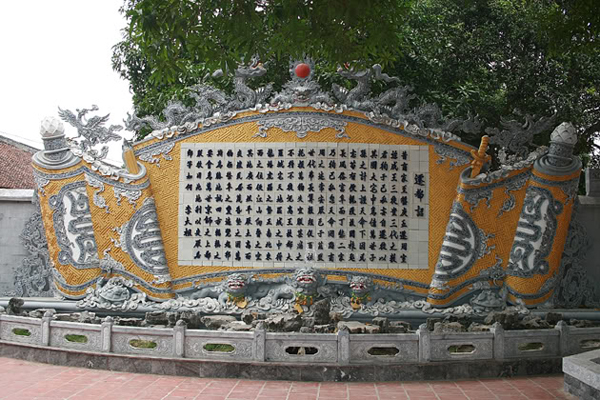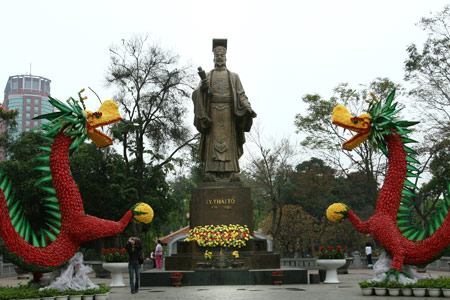In the 10th year of the 21st century, Hanoi will celebrate its millennium. It was in the year 1010 that Kinh Ly Thai To, the founder of the first lasting national dynasty (the Ly), decided to transfer the old capital at Hoa Lu to Thang Long, the present capital. Before the transfer he took the advice of his courtiers in an edict:
"In the old days, the Thuong Dynasty, up to the reign of Ban Canh, changed its capital five times, and the Chu Dynasty, up to the reign of Thanh Vuong, three times.

Could it be that those kings of the period of the Three Dynasties, when moving their capital in this way, had obeyed an unjustifiable whim?
No, they had simply wanted to choose a centre favorable to the edification of an immense undertaking for ten thousand generations to come.
Bowing to the will of Heaven and meeting the aspirations of the people, they moved their capital whenever they deemed it necessary, thus ensuring the country's destiny, its wealth and prosperity.
On the contrary, because such is their will and pleasure, the two dynasties of the Dinh and the Le chose to ignore the will of Heaven and did not follow the example set by the Chu. Obstinately they stayed in this place. Their dynasties were short lived, their fates precarious. The common people were ruined while untold resources remained unused. I suffer greatly from that and am compelled to move the capital to another place. The more so since Dai La, the former capital of His Highness Cao, is located in the heartland of our country. Its location evokes the image of a coiled-up dragon, a squatting tiger. It is situated at an equal distance of the four points of the compass and corresponds to a favorable orientation of the mounts and rivers.
There, the site is sufficiently vast and level, the grounds sufficiently raised and well exposed. The population is protected against floods and river spates, its economy is well developed and prosperous. It is the most beautiful site where are assembled men and resources coming from the four points of the compass: it also makes an excellent capital for a royal dynasty over ten thousand generations. I, therefore, wish to benefit from his favorable location and to move there the capital.
What do you think of that decision, you members of my court?"
Commentary
1. This text, which dates back to the beginning of the 11th century, is classed among the most ancient written documents of Vietnam, perhaps the second earliest in time, after a poem written by a Buddhist monk in the 10th-11th centuries. It was written in Chinese ideograms (Han), the Chinese script being then used in the Far East for official, educational and literary writings as was Latin in Europe in the Middle Ages. That script was the only one used in Vietnam for more than twenty centuries, not only under Chinese rule (2nd century B.C. to A.D. 10th century) but also in the period of independent national dynasties (10th to 19th centuries). Only in the 20th century was it replaced by French (colonial period: 1884-1945) and the Vietnamese romanised script (officially starting with the 1945 Revolution).
2. Let us put that document into the historical context. The Viet national and cultural identity was formed in the first millennium B.C. with the bronze culture. The first Vietnamese State established its capital at the apex of the deltaic triangle of the Red River on the demarcation line between the hilly uplands and the swampy, barely cultivated lowlands. The second State moved its capital to the plain, already grown with rice, to Co Loa (18 kilometers from present-day Hanoi). Then came a 1000-year period of Chinese rule; imperial proconsuls first established their administrative seat north of present-day Hanoi before building the citadel of Dai La in the 9th century on the site of the present capital. Meanwhile, the heads of victorious insurrections against the Chinese were able to stay in power only for brief periods; they preferred to install their head-quarters in their native regions with the exception of Ly Nam De (6th century) who took Hanoi (then Long Bien) as the capital of his short-lived kingdom.
The Chinese yoke was broken in the 10th century. The capital was established at Co Loa by the liberating Ngo Dynasty which ended in anarchy. Order was restored by Kinh Dinh Tien Hoang who for the sake of better defence installed the capital at Hoa Lu, about a huiylred kilometers south of Hanoi, in a hilly region. The following dynasty stayed there.
It was Ly Thai To who was credited with having asserted the location of Hanoi to be the country's capital. His choice was no doubt dictated by the geopolitical conjuncture. For several decades Vietnam had had time to remake the apprenticeship of independence. The central power having been consolidated, economic and cultural conditions made it possible to build a prosperous and powerful kingdom which, indeed, was to enjoy great prestige in Southeast Asia over four centuries. The capital had to be moved to a site favorable to these prospects.
Hanoi obviously seemed to fit that role. A glance at the map shows that all the waterways (and the mountain ranges) converge on Hanoi and continue to the sea like the fingers of one hand. Both river and land routes are most favorable. Protected on its northern flank against possible invasions by mountain ranges, the city easily communicates with the sea and overseas cultures; plains and mountains meet there.

3. Of course, in the time of Ly Thai To, geopolitical reasons vindicating the choice of Hanoi as capital were felt rather than analyzed. The king was obeying two imperative cultural commands:
"Ly Thai To reproached the Dinh and Le dynasties, his predecessors, with having disobeyed the law of heaven by persisting in staying in Hoa Lu, a place not easily accessible. An unjust reproach, for they were compelled to act as they did by reason of security. As for him, he could allow himself to move the capital away in order to "follow the will of Heaven" and the "aspirations of the people".
Once the decision was taken, he had to conform to the rules of geomancy. The capital would be located: "in the head land of the country. Its position evokes that of a coiled-up dragon, a squatting tiger. It is situated at an equal distance of the four points of the compass and corresponds to a favorable orientation of mountains and rivers, which would ensure a royal dynasty lasting ten thousand generations".
4. This text indicates the ambiguous character of the old relations between Vietnam and China, which were governed by the dialectical play of repulsion and attraction. On the one hand, the Vietnamese repulsed all that emanated from the hereditary invader: on the other, they were attracted by a richer culture which often served as a model. Thus, Ly Thai To cited the examples set by Chinese dynasties (Thuong, Chu, the Three Dynasties) and honored the memory of the proconsul Cao Bien.
5. The king called his capital Thang Long the "Soaring Dragon", showing that he remained deeply Viet, for the Viet were believed to descend from the union of a Dragon and a Fairy The mythical animal was thought to bring rain to the rice fields. It represented royalty and nobility.
6. Thang Long or Long Thanh (the Dragon City) has been called Hanoi since 1831, in the reign of the Nguyen Dynasty which fixed its capital in Hue, Hanoi again has resumed the status of capital since the Revolution of 1945.



